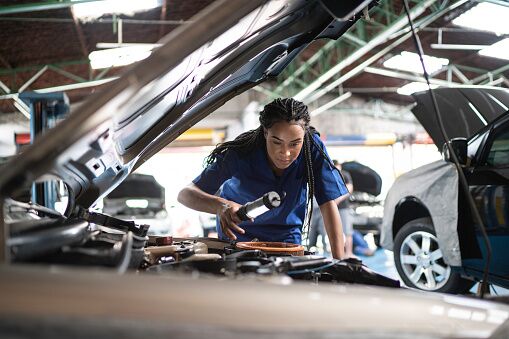All Categories
Featured
Proper tire maintenance is crucial to prolonging the life of your lorry and ensuring a smooth and secure driving experience. 2 of one of the most vital tire solutions are tire rotation and alignment. These services not just protect against premature tire wear but additionally boost handling, fuel efficiency, and overall safety and security. If you're not familiar with what tire turning and placement require, right here's a thorough consider why they matter and how they profit your lorry.
What Is Tire Turning? Tire turning refers to moving your tires from one setting to another to ensure they wear equally. The factor tire turning is necessary is since not all tires put on similarly. In front-wheel-drive vehicles, as an example, the front tires deal with both guiding and power, that makes them put on out faster than the rear tires. The rear tires put on differently in rear-wheel-drive and all-wheel-drive cars.
By rotating your tires on a regular basis, you can cancel the wear throughout all 4 tires. This assists them last longer and enables more also traction, enhancing handling and security. The majority of manufacturers suggest rotating your tires every 6,000 to 8,000 miles or based on the vehicle's manual.
What Is Tire Positioning? Tire positioning, also referred to as wheel alignment, describes the procedure of changing the angles of your car's wheels to satisfy the producer's specs. The objective of positioning is to guarantee that all 4 tires are pointing in the ideal direction and at the right angles, which enables optimal handling, safety, and tire life.
There are three main placement angles that are readjusted throughout a positioning check:

Camber: The tilt of the wheels when watched from the front. If the camber is off, it can lead to uneven tire wear, as the tire will not make complete contact with the roadway surface. Wheel: The angle of the steering axis when checked out from the side. Appropriate caster positioning makes certain that your lorry is stable when driving straight and that your steering wheel go back to its regular setting after a turn. Toe: The angle at which the tires point inward or outward when viewed from above. Wrong toe alignment can trigger the tires to drag, bring about irregular wear and lowered gas effectiveness. Imbalance can occur gradually because of typical driving or from striking barriers like visuals or splits. If your positioning is off, it's important to get it checked and fixed to avoid concerns down the roadway.
Why Tire Rotation and Placement Matter. Enhanced Tire Life:. Normal tire rotation ensures even tire wear, helping you obtain the most mileage out of your tires. Unequal wear can create you to replace tires prematurely, which can be pricey. When your tires use equally, they last longer, saving you cash in the long-term.
Enhanced Vehicle Handling:. Appropriate alignment keeps your car driving straight and stable, particularly at higher speeds. Misalignment can cause your auto to draw away, making it tougher to guide. By keeping your tires straightened, you guarantee your vehicle takes care of a lot more efficiently and naturally.
Improved Safety And Security:. Tires that are not turned or lined up correctly can wear unevenly, affecting how well your vehicle stops and edges. Misaligned tires or tires with unequal wear patterns might cause decreased grip, particularly in damp or icy conditions, leading to a higher danger of mishaps.
Much Better Fuel Efficiency:. Tires that are misaligned can develop moving resistance, implying your engine has to function tougher to relocate the auto. This enhances gas usage and lowers your automobile's gas performance. Correct tire positioning lowers rolling resistance, which can enhance gas mileage.
Indicators Your Tires Required Rotation or Alignment. While it's essential to stay on top of routine tire turnings and alignments, there are a couple of indicators that may show your tires need attention:
Irregular Use: If you discover that a person tire is extra used than the others, it's likely time for a rotation. Guiding Pull: If your auto pulls away or really feels off-center, maybe a sign of imbalance. Resonances: If you feel resonances in the steering wheel or the car, it can be due to a placement problem. Noisy Tires: Screeching or loud tires could show incorrect rotation or imbalance. If you see any one of these indicators, it is necessary to obtain your tires checked by a professional.
How Often Should You Turn and Straighten Your Tires? Tire turning need to normally be done every 6,000 to 8,000 miles, though this can differ based on your driving conditions and the kind of lorry you drive. It's additionally a good idea to have your tires turned whenever you obtain an oil modification.
For alignment, you must have your tires lined up every 1-2 years, or more regularly if you observe any issues with handling or uneven tire wear. If you struck a big hole or curb, it's a good idea to obtain a placement check today.
Conclusion: Routine Upkeep for Optimum Efficiency. Tire turning and placement are 2 straightforward but essential services that maintain your automobile running efficiently, effectively, and safely. By rotating your tires frequently and keeping your wheels correctly aligned, you can prolong the life of your tires, improve handling, and delight in much better fuel performance. Don't wait on your tires to reveal signs of wear-- schedule regular upkeep to maintain your auto in top shape. Normal tire treatment is a financial investment that pays off in the lengthy run, maintaining you and your passengers safe when driving.
Latest Posts
Why Pick Vinyl Secure Fencing for Your Home?
Why Chain-Link Fencing Stands Out?
Why Choose Washington Fence for Your Next Job?